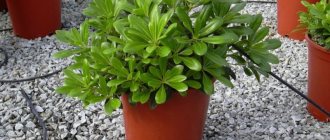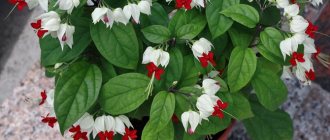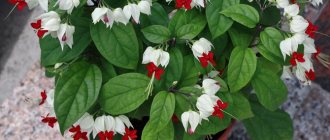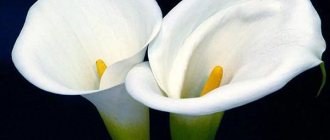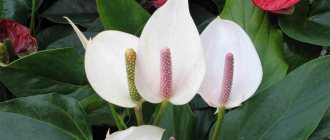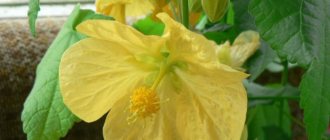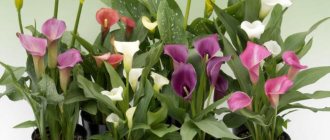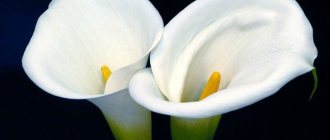Callas belong to the Araceae family. This plant is a perennial, grows in coastal and swampy areas, on the continents of Eurasia, North America and Africa, where a temperate and subtropical climate prevails.
For a flower, calla lilies have an unusual appearance, the stem length is about 80 cm. But this is not the limit, there are also taller varieties. The root system of the calliper is hollow rhizomes with shoots, the total length of which is from 60 to 90 cm. Bright green large leaves reach 30 cm in length, located near the rhizome. They are used in folk medicine as an anti-inflammatory agent.
Flowers similar to Calla lilies
There are two plants incredibly similar to Calla lilies - Spathiphyllum and Anthurium. They are just as beautiful and undoubtedly deserve attention.
Anthurium fire element. It blazes along with the red Calla, Spathiphyllium - “Snow White”. Its flower, as if descended from the mountain peaks, can boldly resist the whiteness of the bride’s dress.
All these plants (including Callas) belong to the Araceae genus. They arrived at the house of a man from the tropics: South America, Argentina, Paraguay and Mexico.
Growing red callas in the garden: care and subtleties
Red calla lilies should be planted in spring, in warm, fertilizer-rich and moist soil, always in a sunny place. You must water them constantly in order for them to grow properly. It is necessary to feed the flower once every three weeks, since not all soils are similar to their native (South African) soil, you should bring this as close as possible. This is all about caring for red callas in the garden.
Place flower beds with white roses nearby and your garden will look like a fairy tale.
Description of plants similar to calla lilies
In indoor floriculture, there are several types of plants similar to calla lilies.
Spathiphyllum
Spathiphyllum also belongs to the Araceae family. Depending on the variety, it grows from 50 to 150 centimeters in height. Its bright green or variegated foliage is collected in a basal tuft. It has an ovoid shape, in some varieties its structure resembles corrugation. The length ranges from 25 to 90 centimeters, and the width from 10 to 40 centimeters. A spathiphyllum flower consists of a yellow or greenish-colored spadix and a spathe.
Unlike calla lilies, the spathiphyllum cover has an oval shape and is located vertically. By the end of flowering, its white color turns greenish.
Anthurium
Anthurium is an evergreen plant belonging to the Araceae. It can reach more than a meter in height. Anthurium has shiny, tough, solid foliage of a dark green color. It is heart-shaped and up to 40 centimeters long. The flower spadix may be white, pink or yellow.
Unlike calla lilies, the bract, like the leaves of the plant, is heart-shaped and is located around the cob, perpendicular to it.
The blanket can be white, salmon, pink or purple. But, for some reason, today varieties that have only red flowers are most often grown. People often call them “tongues of fire”, “flamingo flowers” or “men’s happiness”. It is believed that anthurium gives a man strength and brings happiness and good luck to his home.
Zantedeschia
Zantedeschia, like callas, is a perennial flowering plant belonging to the Araceae. Its underground part can be either a rhizome or a bulb. Depending on the type, its bushes can produce stems from 50 centimeters to 1 meter in height.
The foliage of the plant is bright green in color and heart-shaped. The appearance of the flower resembles a calla lily. It consists of a yellow cob and, depending on the varietal variety, can be white, pink, greenish, yellow, cream with a lemon tint, lilac-cherry, dark purple.
Whitewing
Calla palustris is a member of the evergreen perennials of the Araceae family. It is a small compact plant about 30 centimeters tall. Its heart-shaped green foliage in some varietal specimens may be covered with white or yellowish spots. They have a length from 6 to 14 centimeters and a width from 5 to 11 centimeters. The ear of the calla lily, like that of calla lilies, is yellow in color. The inside of the bedspread is painted white, and the outside is greenish.
There are not many indoor flowers that look like calla lilies. But, in addition to the fact that they belong to the same family and have some visible similarities, they also have a number of clearly visible differences, for example, in the shape of foliage and bedspread. Therefore, having studied the features of their structure, you can easily determine their name. This will help determine their further content, which will contribute to the proper development and abundant flowering of plants.
Ethiopian calla (Zantedeschia aethiopica)
Calla Ethiopian is the largest variety of Zantedeschia for growing indoors. This species has large heart-shaped leaves and funnel-shaped inflorescences. During the dormant period, the foliage remains bright green, which increases the decorative appearance of the species.
The most famous varieties of Ethiopian calla lilies include:
- “Green Goddess” is a variety with white-green flowers and a short lemon-colored stamen.
- “Childsiana” - the variety blooms profusely with snow-white flowers with an orange center.
- “Amethyst” is a variety of purple calla lilies that are distinguished by their considerable height and delicate aroma.
- “Pearl” is a tall variety with light green leaves, the flowers are large, white, fragrant, with a greenish tint on the outside. Suitable for bouquets.
- "Albomaculata" - a large white flower with a candle shape and a light vanilla aroma.
- "Captain Chelsea" is a beautiful two-color variety. The bedspread is burgundy with a golden border. The leaves are dark green with silver dots.
- "Little Gem" - calla has white flowers of the original appearance. A flower that has not fully blossomed has a petal that curls like a funnel, with a bright yellow stamen in the middle. At the edge of the petal there is a greenish outgrowth-claw.
Tips on how to preserve red kala flowers after cutting
Cut flowers should be stored in fresh water and always in a clean vase. The water they are in should not be too cold nor too warm - room temperature water is ideal. Cut flowers should be stored in a cool place, away from direct sunlight, which will cause them to suddenly wilt.
Cut flowers red calla lilies in the photo.
Red calla flowers dominate people's feelings. Their message to people is very clear: LOVE! They spread it in all their shades, and bouquets of different shapes are intended for different types of events. These are bright, loud, presentable flowers that will help you express your feelings whenever you are at a loss for words!
Problems with indoor calla lilies and their solutions
| Problem | Cause | Solution |
| The stems are stretched. | Not enough light, very warm. | Change the location, install additional lighting, lower the room temperature. |
| The plant does not bloom. | The rest period has not been maintained. | During wintering, stop watering and reduce lighting. Before flowering, fertilize. If the rhizome grows large, divide it or plant the tubers. |
| Fragility of petioles. | Lack of nutrition. | Fertilize every week with fertilizers containing nitrogen and superphosphate. |
| Plaque on the leaves. | Fungal disease powdery mildew or gray rot. | Treat the leaves with a solution of potassium permanganate or soda ash with soap. Spray with fungicidal preparations: Fundazol, Vecta, Topaz, etc. |
| Non-seasonal leaf shedding. | Root rot. | Reduce watering, replace the soil. |
Tuberous indoor callas
Callas sprouted from tubers, unlike those that feed on rhizomes, do not require high soil and air humidity, but do not tolerate drought well. It is optimal to carry out regular watering, avoiding waterlogging of the soil and preventing the soil from drying out, forming cracks.
The homeland of indoor plants is still South America. Thanks to the work of breeders, it became possible to grow the free-spirited beauty in pots on windowsills, without limiting oneself to snow-white varieties at all.
Elliott
When callas of this variety bloom, you can observe harmonious tints: the outer surface of the petal is light green, the inner surface is bright yellow. The variety blooms profusely, which cannot but please gardeners. The window sill will be a bright accent in the room for many summer months.
Aethiopica
The most popular variety of indoor plant is aethiopica. The flowering is distinguished by a dense funnel, widening towards the top. The flower stalk can reach a meter in height, with the right choice of pot and a sufficient amount of diffused light. White callas love moisture more than other varieties of tuberous representatives of this family. Therefore, to obtain abundant flowering, it is important to keep the soil in the pot moist.
Attention! If the top layer of soil looks dry, but already at a depth of 1 cm the soil is moist, there is no need to water the plant - this will lead to excess moisture, which can contribute to the rotting of the tuber.
Picasso
Calla variety Picasso is distinguished by the uneven color of the inner side of the petal. The core is colored purple, going deep, creating a contrasting background for the yellow cob of the core. The edges of the inner side and the entire outer surface are white. Growing calla lilies of this variety in a pot requires the presence of water in the tray. The room temperature should be close to 22˚C.
Odessa
Calla variety Odessa has won the hearts of lovers of wine shades. With sufficient lighting, it can acquire a dark ruby color, sometimes very close to black. Callas do not differ in flowering duration from the standard indicators of their relatives - from July to the first days of September, the flower will delight with its deep, rich color.
Attention! All tuberous and rhizomatous callas are not frost-resistant and are not able to withstand frost without outside help. Therefore, tuberous varieties are cleaned of dried leaves, the tuber is wrapped in cloth and stored in a ventilated container in a cool, dark place.
Mango
The variety got its name because the blooming calla lilies resemble mangoes in color. Sometimes it may even seem that someone has laid out the ripe fruits of a tropical plant among the greenery - this is how calla lilies bloom lusciously and give a subtle sweet aroma. A bright picture can be observed from the beginning of August, when the first petals appear. The rest of the spring-summer period, the plant increases its green mass in order to gain strength for luscious flowering.
This variety requires 12 hours of daylight, which ensures rich shade.
Callas Mix are the most adapted to apartment maintenance; they are also called the colored variety. They are less afraid of drafts and temperature changes, but still you should not intentionally create extreme conditions even for such a resistant variety, so as not to shorten the flowering period. The petal can take on several shades: from pink to purple. Callas of this variety are called mix because the flowering options are ambiguous.
Basic measures for caring for home calla lilies
Considering the structural features of this decorative flower and its southern origin, caring for it will be slightly different.
Watering and lighting mode
When growing this decorative flower, it is necessary to regularly irrigate. Otherwise, the plant will very quickly stop its growth and begin to wither. It is highly susceptible to wet soil.
, which grow in swampy areas, cannot tolerate dry soil in a pot It needs intensive watering during the period of active growth.
But colored varieties do not need to be moistened abundantly ; it is also necessary to prevent liquid from stagnating in the pan. Such carelessness can provoke the development of diseases, in particular, it will lead to rotting of the root system.
The optimal water temperature for irrigation is room temperature (+18-20 degrees) , it must be used when the soil is 2-3 cm dry.
To make the plant feel comfortable, it is recommended to maintain indoor humidity within 70-80% . Rubbing its leaves with a damp cloth and moss or moistened expanded clay placed on a tray has a beneficial effect on the flower.
You can reduce the frequency of irrigation procedures after the flowering period has ended. This applies to all varieties of calla lilies. After 1-2 months, colored varieties can be completely stopped watering.
It is not recommended to abruptly transfer the flower into the resting phase by trimming the leaves or stopping watering. Here, it is important to let the tubers fully ripen. Depending on the growing conditions, the resting phase may vary, but in most cases this period falls in October - November.
Calla is a fairly light-loving plant that requires good lighting throughout the year. There is a shortage of light, especially in winter. The crop does not bloom, only shoots grow.
White flowers require good lighting even in the resting phase. Colored callas in conditions of lack of light lose their specific shade.
Recommended temperature
Two factors have a negative impact on all types of this plant: low humidity and high temperature . If the room temperature changes sharply, the crop stops blooming.
During the growing season, varieties with white color must be grown at a temperature of +18-20 degrees. It is recommended to reduce it gradually, to 10-12 degrees, after the completion of the flowering phase. The duration of the rest period can last up to two months.
The optimal temperature regime for colored varieties is +20-24 degrees. With minor temperature fluctuations, such specimens do not react sharply, but, on the contrary, the formation of leaves and tubers begins to occur more efficiently.
In order for the tubers to ripen better, after flowering they are kept for one month at a temperature of +25-27 degrees, without watering. As soon as they are ripe, the leaves are removed and placed in a dry wintering area, sprinkled with sawdust, at a temperature of +3-5 degrees.
What soil and fertilizing do feces need?
Plants develop better and faster on acidified ones.
- two parts of turf land
- one part of leaf soil
- one part peat
- one part sand
Timely application of nutrients will be the key to high-quality cultivation of this magnificent plant. Flowers can receive full nutrition by transplanting them into open soil for a warm period.
If you keep it permanently in a container (pot), then you can’t do without complex fertilizers. The interval between procedures should be 10-14 days, where nutritional compositions must be alternated.
Applying fertilizers to the soil
To prevent excessive growth of green mass by the plant, which negatively affects the quality of flowering, it is necessary to apply nitrogen-containing fertilizers in doses during the growing season.
After the flower stalks appear, it is good to feed the crop with urea, and during the flowering period it is better to use an infusion of eggshells.
Rules for transplanting home calla lilies
As soon as the dormant period ends, you can begin replanting the flower in fresh soil. If you regularly pinch out new shoots and change the top layer of soil in the container (pot), then the need for replanting will disappear for two years.
The plant must be planted in containers that fully correspond to the size of the tubers; they should be more than 15 cm in diameter. There is no need to use pots that are too deep.
You can use a universal composition for ornamental plants by first placing a 5 cm drainage layer on the bottom of the pot.
A three-liter container is suitable for replanting a flower.
After transplanting the crop, the temperature in the room must be gradually increased. During the period of active growth - 2-3 weeks after transplantation, you can begin to feed the flower and irrigate it generously with warm water.
How to propagate callas
The rhizome of this ornamental plant is presented in the form of bulbs, which grow over time by division and occupy a significant area. To provide the plant with comfortable conditions, excess is dug up, replanted, or completely thrown away.
It is correct to plant the planting material in a horizontal position , making a hole 10 cm deep. For better growth, the soil after planting the tuber is watered generously with water at room temperature.
When separating tubers, you should leave at least one bud on each part, performing the manipulation by hand.
Breeders are engaged in the propagation of calla lilies through seed material. At home, the seeds must be kept in clean water for about 6 hours in advance with the addition of a natural biostimulant - potassium humate.
Flowers that look like calla lilies
Indoor plants serve as a real decoration for the home and give it comfort and elegance, but in addition to their aesthetic function, they also serve as air purifiers. Indoor flowers with snow-white buds look especially elegant and delicate.
Overview of species
Indoor plants with white flowers are quite numerous and varied. They differ in both appearance and care requirements, but they are united by the white color of their buds.
Azalea
At home, this evergreen shrub grows no higher than 50 cm. Thanks to its lush and long-lasting flowering, the plant has gained extreme popularity. Large azalea buds are simple and double, the leaves are lanceolate, densely pubescent on the reverse side and located on branched shoots. Two varieties are most suitable for home cultivation: Melina (Japanese) and Stella Maris (Indian).
- The Japanese one has a more compact size and a highly decorative appearance; the entire bush is densely strewn with small buds. They can grow either singly or in inflorescences.
- Indian has dark green oval leaf blades and rather large buds. The central petals are strewn with crimson splashes. Flowers can be of different types: simple, double or corrugated.
Gardenia
The evergreen plant can grow either as a compact bush or as a tiny tree. In an apartment, the flower reaches a maximum height of 70-100 cm. Dense small leaves have a glossy surface with pronounced venation and grow in 2 or 3 pieces. The flowers are tubular, with a pronounced pleasant aroma. The most popular variety is the jasmine gardenia.
Large white-cream buds smell strongly of jasmine and form corymbose inflorescences of 4-6 pieces.
The plant belongs to vines, so it needs support. The leaf blades are oval in shape, at first they have a glossy surface and then become matte. The buds are not particularly large, but have an unusual star-shaped shape and form small inflorescences. The flowers are mainly white, but in the middle they acquire red or crimson shades. The following varieties of hoya are suitable for growing indoors: green, beautiful, motoskei.
Spathiphyllum
This striking representative of the aroids is distinguished by a very impressive appearance and the absence of pronounced shoots, very similar to calla lilies. Elongated leaf blades grow almost from the root. The flowers also have a rather unusual appearance: on the flower arrow there is a yellow spadix, wrapped in a white blanket of wide petals. The plant has many varieties, both tall and dwarf.
Among them the most famous are: “Abundantly Flowering”, “Picasso”, “Chopin”, “Sensation”, “Cannoleaf”.
White orchid
The plant is distinguished by a thick stem on which large buds grow. White flowers are rare; most often the petals have an edging or inclusions of a different color. The most popular varieties with white petals include the following:
- “Royal” is distinguished by large flowers, about 15 cm in diameter;
- "Vanda" is characterized by long flowering and a pleasant caramel scent of small flowers;
- “Butterfly” is distinguished by unusual petals, shaped like insect wings;
- "Heron" has flowers that resemble a bird in flight.
Stephanotis
Of the many plant species, only Stephanotis floribunda, a profusely flowering liana, is cultivated. The small leaves are oval in shape and have a glossy surface. The stems are quite flexible, although thick, and can easily be formed into a bush on supports. The flowers consist of 5 petals, have a waxy surface and are collected in small bunches.
Plumeria
The plant is noteworthy for its unusual aroma, which is more intense in the morning and becomes weaker in the evening. It combines citrus and jasmine scents with notes of lily of the valley and spices.
Indoor plumeria can grow up to 2 m and can look like a bush or tree.
The leaf blades are quite large, the surface below has white pubescence. The flowers are small, with five petals, the center of which is bright yellow.
